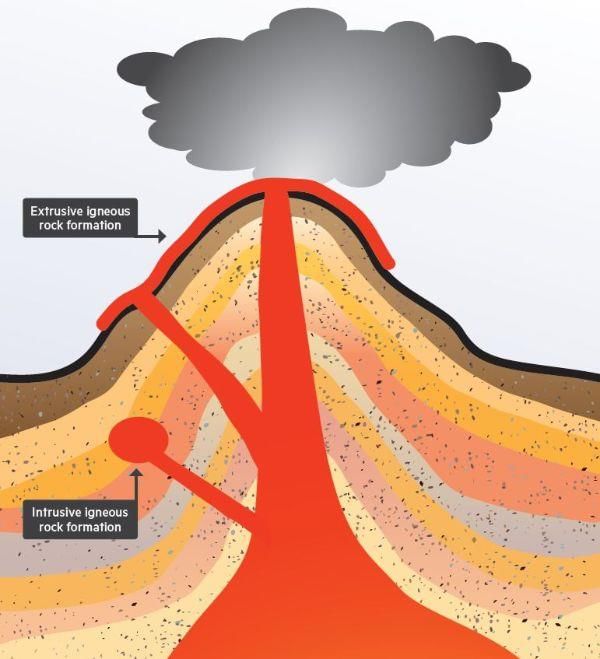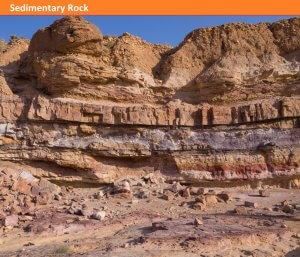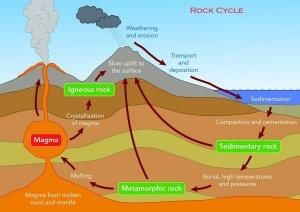UPSC Exam > UPSC Notes > Famous Books for UPSC Exam (Summary & Tests) > Type of Rocks
Type of Rocks | Famous Books for UPSC Exam (Summary & Tests) PDF Download
Rock System
The Earth’s crust is made up of various types of rocks, and the scientific study of rocks is called petrology.
These rocks differ in ;
- Texture – the degree to which something is rough or smooth, or soft or hard
- Structure – how the parts of a system or object are arranged or organised, or a system arranged in this way
- Mode of occurrence
- Colour
- Permeability – allows water, gas to pass.
- Degree of resistance to denudation
According to origin and appearance rocks can be divided into three groups –
- Igneous rocks
- Sedimentary rocks
- Metamorphic rocks
Igneous Rocks
You can remember it by word ignite, which means to burn. So, igneous rocks are formed after cooling and solidifying molten rock (magma) from beneath the Earth’s crust.
- Rocks formed out of solidification of magma (molten rock below the surface), and lava (molten rock above the surface) is known as igneous or primary rocks.Question for Type of RocksTry yourself:Study of rocks is called asView Solution
- Structure – crystalline
- They do not occur in strata (layers), nor do they contain fossils.
- These rocks can be subdivided based on mineral composition.
- Acid Igneous rocks
(i) The high proportion of Silica
(ii) Less dense
(iii) Lighter colour than basic rocks
(iv) Example – Granite, quartz and feldspar - Basic igneous rocks
(i) The low proportion of Silica
(ii) Denser and Dark colour
(iii) Example – Basalt, gabbro and dolerite
- Acid Igneous rocks
Classification of Igneous rocks based on origin
- Plutonic Rocks or (Intrusive igneous rocks)
- Volcanic Rocks or (Extrusive igneous rocks)

Plutonic Rocks or (Intrusive igneous rocks)
- Formed – In-depth of earth’s crust
- Usually medium to coarse-grained texture due to slow cooling.
- Typically, light colour.
- Example – Granite, Diorite and Gabbro
- It is exposed at the surface by the process of denudation and erosion.
Volcanic Rocks or (Extrusive igneous rocks)
- Sudden cooling of magma just below the surface or lava above the surface
- Fine-grain because of rapid cooling
- Denser and darker in colour
- Example – Basalt
- Places where these are found-
(i) Antrim – Northern Ireland
(ii) Deccan plateau – India
(iii) Snake plateau – Columbia - Example of polygonal columns – Columnar basalt of Giant’s Causeway in Antrim
Sedimentary Rocks
- Sedimentary rocks are formed by lithification― consolidation and compaction of sediments.
- Hence, they are layered or stratified of varying thickness. Example: sandstone, shale
- Sediments are a result of denudation (weathering and erosion) of all types of rocks.
- These rocks cover 75 per cent of the earth’s crust but volumetrically occupy only 5 per cent (because they are available only in the upper part of the crust).
- Ice deposited sedimentary rocks are called till or tillite. Wind-deposited sediments are called loess.

Depending upon the mode of formation, sedimentary rocks are classified into:
- Mechanically formed — sandstone, conglomerate, limestone, shale, loess.
- Organically formed — geyserite, chalk, limestone, coal.
- Chemically formed — limestone, halite, potash.
Mechanically formed sedimentary rocks
- They are formed by mechanical agents like running water, wind, ocean currents, ice, etc.
- Example – Sandstone which is made of Sand grains, quartz fragments.
- You have seen in Rajasthan and other places that sandstone is used to build homes.
- Sandstone use –
(i) Buildings
(ii) Grindstones - Sandstone types –
(i) Grit – coarser type sandstone
(ii) Conglomerate – larger pebbles firmly cemented to form a rock
(iii) Breccia – when the fragments are angular - Clay – finer sedimentary materials
(i) Use – brick making, shale or mudstone
Organically formed sedimentary rocks
- Formed by – The remains of plants and animals are buried under sediments, and due to heat and pressure from overlying layers, their composition changes.
- Calcareous type rocks – limestone and chalk
Limestone (called as chuna in Hindi) – the one which is used in Pan and to whitewash home - Carbonaceous rocks – formed of vegetative matter
You know how coal is formed (a lot of pressure and heat compacted the plant remains carbon, which becomes peat, lignite or coal).
Chemically formed sedimentary rocks
- Formed of – one kind or another solution which is precipitated chemically
- Example –
(i) Rock salt – derived from old sea bed or lakes
(ii) Gypsum – evaporation of Salt Lake.
(iii) Potash and nitrate are also obtained similarly.
Metamorphic Rocks
- The word metamorphic means ‘change of form’.
- Metamorphism is a process by which recrystallisation and reorganisation of minerals occur within a rock. This happens due to pressure, volume and temperature changes.
- When rocks are forced down to lower levels by tectonic processes or molten magma rising through the crust comes in contact with the crustal rocks, metamorphosis occurs.
- In the process of metamorphism in some rocks, grains or minerals get arranged in layers or lines. Such an arrangement is called foliation or lineation.
- Sometimes minerals or materials of different groups are arranged into alternating thin to thick layers. Such a structure is called banding.
- Gneissoid, slate, schist, marble, quartzite are some examples of metamorphic rocks.
- Causes of Metamorphism
(i) Orogenic (Mountain Building) Movements: Such movements often occur with an interplay of folding, warping and high temperatures. These processes give existing rocks a new appearance.
(ii) Lava Inflow: The molten magmatic material inside the earth’s crust brings the surrounding rocks under the influence of intense temperature pressure and causes changes in them.
(iii) Geodynamic Forces: The omnipresent geodynamic forces such as plate tectonics also play an essential role in metamorphism.
Based on the agency of metamorphism, metamorphic rocks can be of two types.
- Thermal Metamorphism
- The change of form or re-crystallisation of minerals of sedimentary and igneous rocks under the influence of high temperatures is known as thermal metamorphism.
- A magmatic intrusion causing thermal metamorphism is responsible for the peak of Mount Everest consisting of metamorphosed limestone.
- As a result of thermal metamorphism, sandstone changes into quartzite and limestone into marble.
- Dynamic Metamorphism
- This refers to the formation of metamorphic rocks under high pressure.
- Sometimes high pressure is accompanied by high temperatures and the action of chemically charged water.
- The combination of directed pressure and heat is very powerful in producing metamorphism because it leads to more or less complete recrystallisation of rocks and new structures' production. This is known as dynamo thermal metamorphism.
- Under high pressure, granite is converted into gneiss; clay and shale are transformed into schist.
Some examples of Metamorphosis

Metamorphic Rocks in India
- The gneisses and schists are commonly found in the Himalayas, Assam, West Bengal, Bihar, Orissa, Madhya Pradesh and Rajasthan.
- Quartzite is a hard rock found over Rajasthan, Bihar, Madhya Pradesh, Tamil Nadu, and Delhi.
- Marble occurs near Alwar, Ajmer, Jaipur, Jodhpur in Rajasthan and parts of Narmada Valley in Madhya Pradesh.
- Slate, which is used as a roofing material and for writing in schools, is found over Rewari (Haryana), Kangra (Himachal Pradesh), and Bihar.
- Graphite is found in Orissa and Andhra Pradesh. Question for Type of RocksTry yourself:Which of the following is not a metamorphic rock?View Solution
Rock Cycle
- Rock cycle is a continuous process through which old rocks are transformed into new ones.
- Igneous rocks are primary rocks, and other rocks form from these rocks.
- Igneous rocks can be changed into sedimentary or metamorphic rocks.
- The fragments derived out of igneous and metamorphic rocks form into sedimentary rocks.
- Sedimentary and igneous rocks themselves can turn into metamorphic rocks.
- The crustal rocks (igneous, metamorphic and sedimentary) may be carried down into the mantle (interior of the earth) through subduction process and the same meltdown and turn into molten magma, the source for igneous rocks
- Example –
(i) Clay → Slate
(ii) Limestone → Marble
(iii) Sandstone → Quartzite
(iv) Granite → Gneiss
(v) Shale → Schist
(vi) Coal → Graphite (one which is in our pencil)

The document Type of Rocks | Famous Books for UPSC Exam (Summary & Tests) is a part of the UPSC Course Famous Books for UPSC Exam (Summary & Tests).
All you need of UPSC at this link: UPSC
|
773 videos|1444 docs|633 tests
|
FAQs on Type of Rocks - Famous Books for UPSC Exam (Summary & Tests)
| 1. What is the rock system? |  |
Ans. The rock system refers to the process through which rocks are formed, broken down, and reformed over time. It involves various geological processes such as weathering, erosion, and deposition.
| 2. What is the rock cycle? |  |
Ans. The rock cycle is a continuous process that describes how rocks are transformed from one type to another over time. It involves three main rock types: igneous, sedimentary, and metamorphic rocks, which can change through processes like cooling and solidification, weathering and erosion, and heat and pressure.
| 3. How are igneous rocks formed in the rock system? |  |
Ans. Igneous rocks are formed when molten magma cools and solidifies either beneath the Earth's surface (intrusive igneous rocks) or on the surface (extrusive igneous rocks). This process can occur through volcanic activity or the cooling of magma chambers.
| 4. What are some examples of sedimentary rocks in the rock system? |  |
Ans. Some examples of sedimentary rocks include sandstone, limestone, shale, and conglomerate. These rocks are formed from the accumulation and compaction of sediments, such as sand, mud, and organic materials, over long periods of time.
| 5. How do metamorphic rocks form in the rock system? |  |
Ans. Metamorphic rocks are formed when existing rocks undergo significant changes due to heat and pressure deep within the Earth's crust. This can occur from tectonic forces, such as mountain-building events, which cause the rocks to recrystallize and change their mineral composition and texture.
Related Searches






















